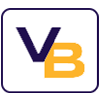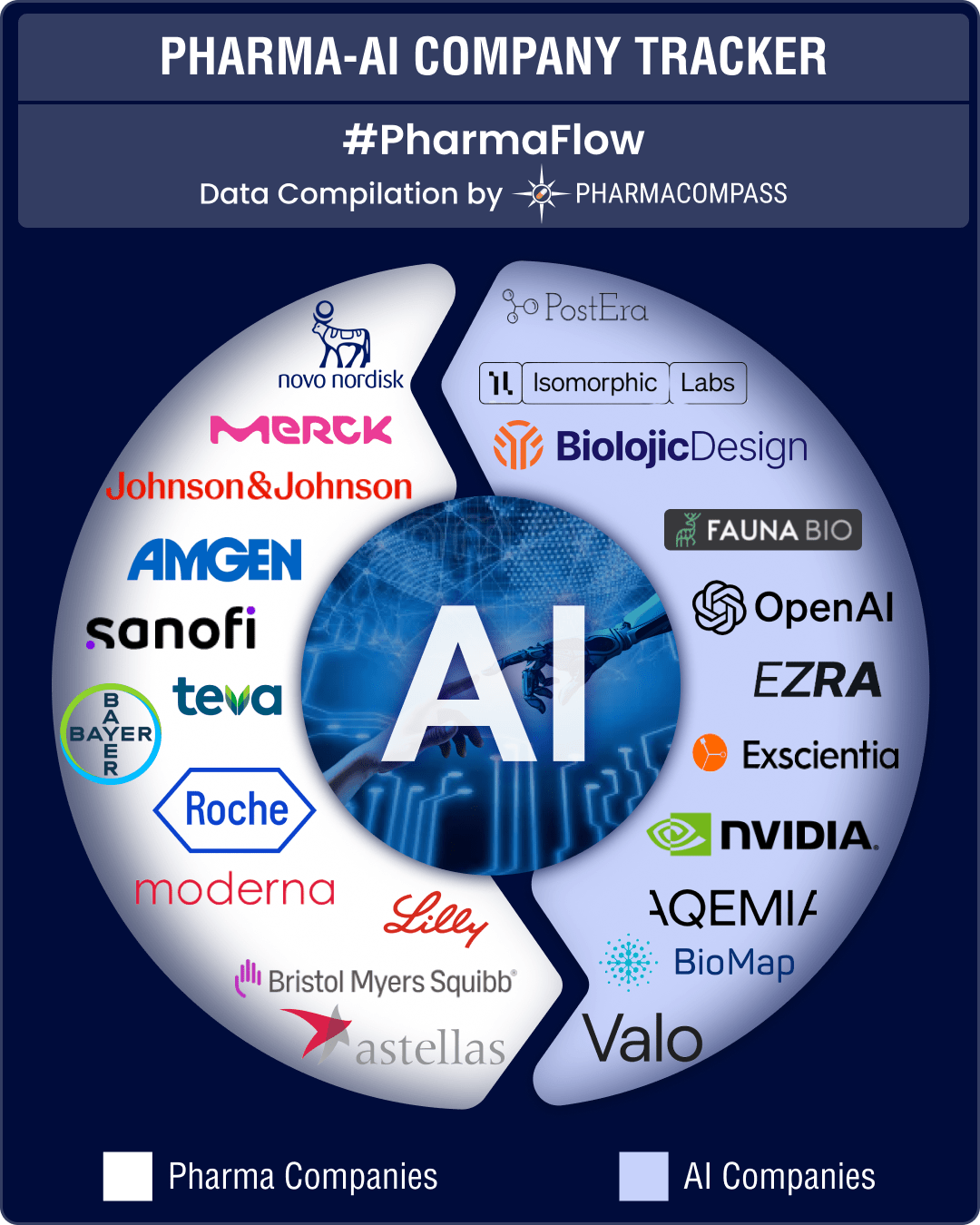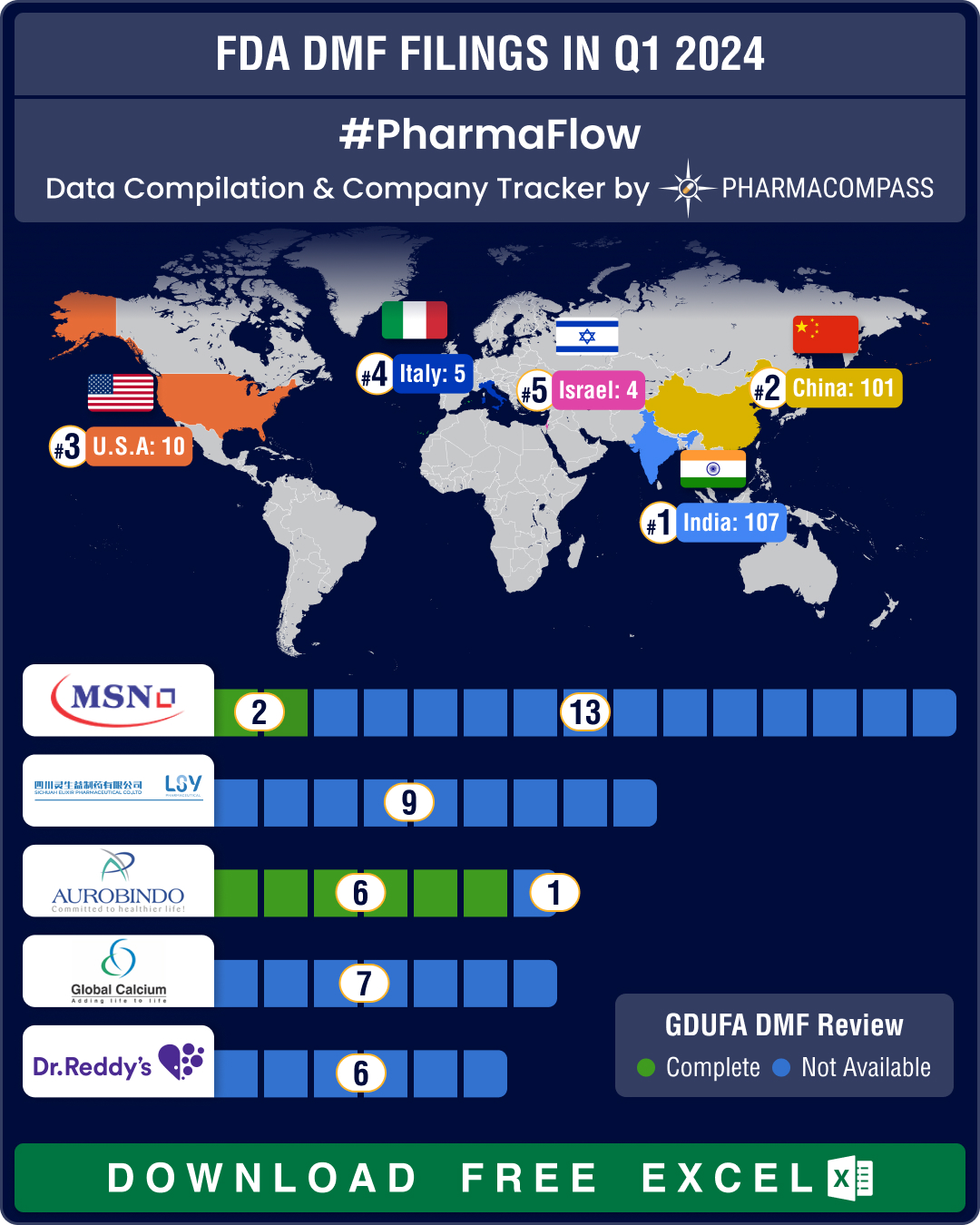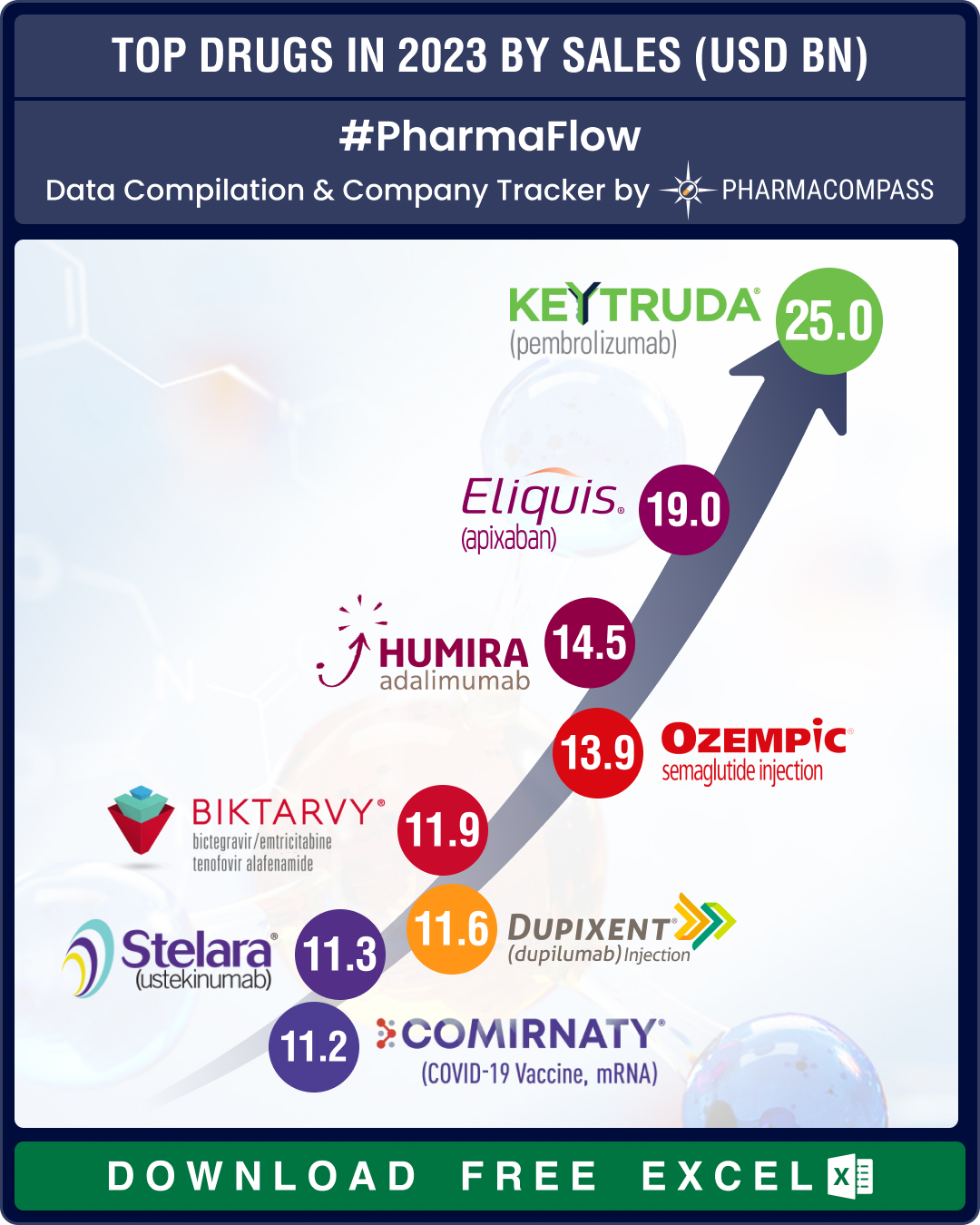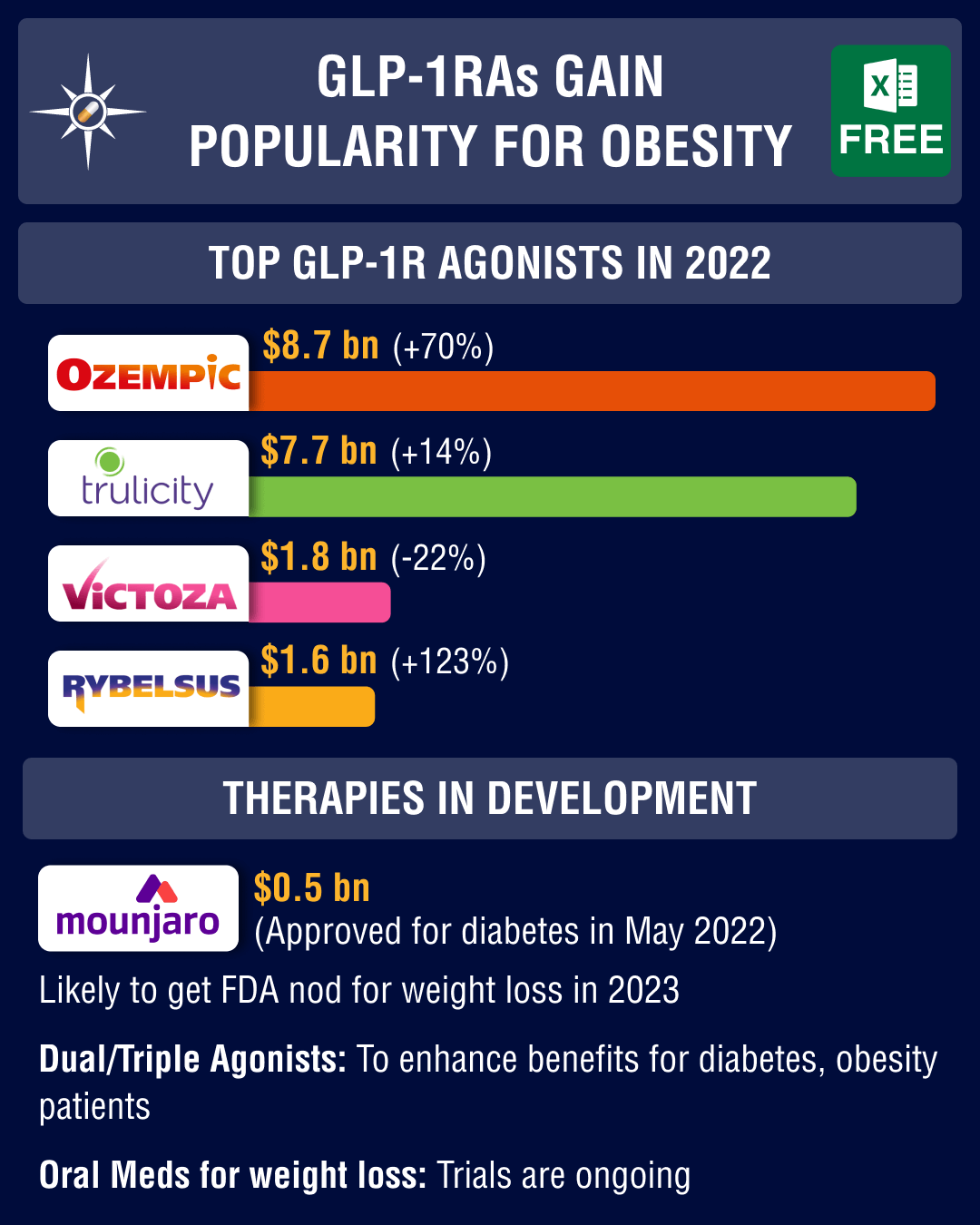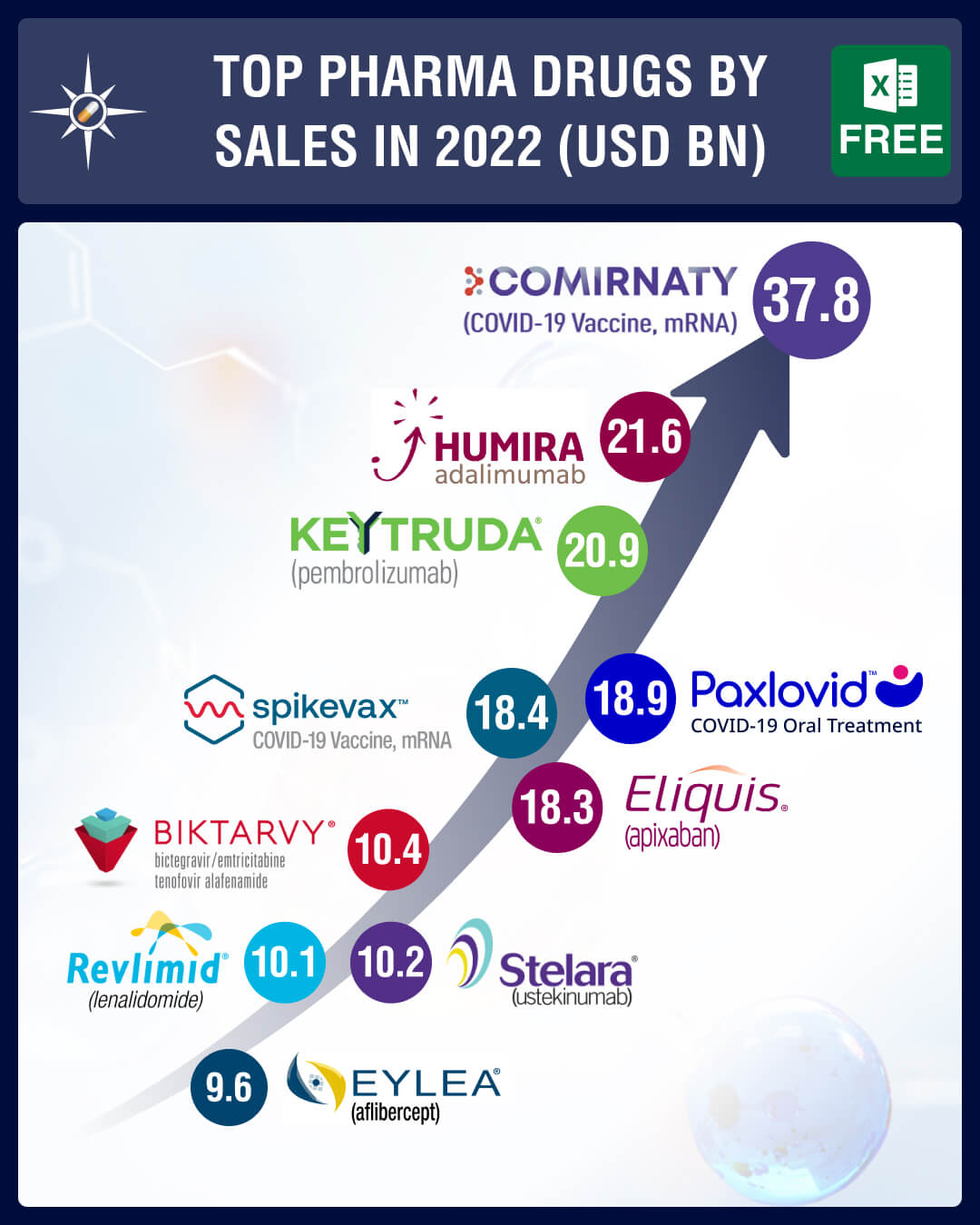Artificial intelligence (AI) is changing the world and bringing
efficiencies across all industries. Pharmaceuticals is one of them. AI can
accelerate drug discovery, streamline clinical trials, and personalize
medicine. It holds the potential to revolutionize the pharma industry.It takes anywhere between 10 to 15 years and around US$ 3 billion to take a new drug from its
discovery phase to the market. AI can drastically cut both the timespan and
costs and bring life-saving yet affordable treatments to the market at a faster
pace. The global AI market in healthcare was estimated to be about US$ 21
billion in 2024 and is expected to grow to over US$ 148 billion by 2029, compounding at an annual
growth rate of 48.1 percent.Drugmakers are eager to ride the AI wave. Players like Bayer, Merck KGaA, Moderna, BMS, Roche, Astellas, Amgen, Eli Lilly, Sanofi, Novo Nordisk and Johnson & Johnson have announced
collaborations, signed deals and entered into partnerships in the AI space.
Many others, such as Exscientia, Insilico, Berg, Nimbus, Recursion, and Pharos iBio, are a step ahead and are holding clinical trials on drugs developed using AI.On its part, the US Food and Drug Administration (FDA) has
recognized the increased use of AI and machine learning (ML) and has reiterated its commitment to ensure the safety and efficacy of drugs “while facilitating innovations in their development.” To this end, the US agency
published a paper in March that lists out its
approach towards the use of AI.Novo, Lilly turn to AI for
drug discovery; AI-based firms sign multiple dealsWith increased adoption of wearable devices, e-health services and
other technology-driven offerings in medicine and healthcare, there is valuable data out there that drugmakers can analyze to get more accurate predictions of a drug’s effects on the human body. Such an analysis speeds up drug development and reduces side effects of therapies. Ergo, several large drugmakers have
signed crucial AI deals. For example, Novo Nordisk has inked a potential US$ 2.7 billion deal with Valo Health to discover and develop novel treatments for cardio-metabolic diseases. The collaboration between the two organizations will leverage the capabilities of Valo’s Opal Computational Platform, including access to real-world patient data, AI-enabled small molecule discovery and Biowire human tissue modeling platform designed to speed up the discovery and development process.Similarly, Eli Lilly has entered into a US$ 494 million deal with Fauna Bio to use the latter’s AI platform — Convergence — for preclinical drug discovery efforts in obesity. Convergence analyzes genomic data from 452 mammal species and various tissue types to
create a comprehensive dataset. By integrating human data and information from
animals with natural disease resistance, the platform can identify potential
drug targets.AI-based pharma firms like Isomorphic Labs and Biolojic are also landing multiple deals. Isomorphic is owned by Google’s parent Alphabet. Along with Google DeepMind, it has created a new AI model that can
accurately predict 76 percent of protein interactions with
small molecules. In January, Isomorphic inked deals with Novartis and Lilly for a combined
value of nearly US$ 3 billion.Biolojic Design uses computational biology and AI to transform
antibodies into programmable, intelligent medicines. Earlier this month, it
announced a multi-target drug discovery collaboration
with Merck KGaA, which includes
antibody-drug conjugates. Biolojic has also inked deals with Teva and Nektar recently.Amgen harnesses generative
biology for protein-based drugs; Sanofi ties up with OpenAIFinding a good protein drug candidate is like finding a needle in
a haystack. Drug developers typically start by looking at proteins in nature and then go through the painstaking process of shaping them into safe and effective drugs.Generative biology is a revolutionary approach to drug discovery
and development that leverages ML and AI to design novel protein therapeutics. Amgen is using generative biology to innovate new protein-based drugs that have desired structures and properties based on existing protein data inputs. In fact, the California-based multinational has said it is “integrating AI across all operational levels.” It has collaborated with PostEra to advance up to five small molecule programs.Amgen is building AI models trained to analyze one of the world’s largest human datasets on an NVIDIA full-stack data center platform, known as DGX SuperPOD, that will be installed at Amgen’s deCODE genetics’ headquarters in Reykjavik, Iceland. This system will be used to build a human diversity atlas for drug target and disease-specific biomarker discovery, providing vital diagnostics for monitoring disease progression and regression.AI can analyze individual data like genetic makeup,
lifestyle and medical history to come up with personalized therapies. Amgen is working on
AI-driven precision medicines, and potentially individualized therapies, at its
Iceland facility.Sanofi too has signed multiple deals in recent months. In May,
the French drugmaker signed a collaboration with ChatGPT maker OpenAI and Formation Bio to build AI-powered software to accelerate drug development. Sanofi is also collaborating with BioMap in a deal that could be
worth up to US$ 1 billion. The deal is expected to
enable superior prediction from limited data in a range
of therapeutic areas, including immunology, neurology, oncology, and rare
diseases.AI tools can create control
arms, digital twins and slash failure rate in clinical trialsTraditional ways of drug development are fraught with challenges,
and 90 percent of drug candidates in clinical trials tend to fail. Major reasons behind this are poor patient cohort selection and recruiting mechanisms, and the inability to monitor patients effectively during trials. AI tools like Trial Pathfinder study real data obtained from patients’ electronic health records and simulate clinical trials for the drug with different eligibility criteria. Trial Pathfinder also calculates trial hazard ratios, a scientific term that compares the survival rates of those given and not given the drug.AI and synthetic data can also be used to create control arms in
clinical trials, which can help speed up the process, reduce costs, and improve
the quality of data. For example, FDA has supported the use of a Medidata Synthetic Control
Arm in a
phase 3 trial of Medicenna’s MDNA55 in recurrent
glioblastoma.In addition to observing real-time patient data, researchers can
also create digital twins, virtual replicas of cells,
organs, or people, which they can use to simulate and predict various clinical
outcomes during a trial.Our viewThe
pharmaceutical industry is on the cusp of a revolution. In the coming years, we
hope to see some tangible results of the efforts being put in by drugmakers, AI
developers and regulatory agencies. The CPhI Annual Report 2023 has predicted
that in 2030, over half of FDA-approved drugs will involve AI in their development and/or manufacturing. The winner, in our view, will be the end-user who will have cheaper, safer and more effective treatments, delivered at a faster pace.
Impressions: 1310
Generic drugs play a crucial role in providing access to life-saving drugs at affordable prices. To that end, drugmakers submit Drug Master Files (DMFs) or their ‘recipes for making generics’ to the US Food and Drug Administration (FDA) for review. Of these, Type II DMFs involve active pharmaceutical ingredients (APIs) for both branded and generic drugs.PharmaCompass has been reviewing Type II
submissions for several years now. We have noticed that these filings have been
increasing in recent years. There has been a 33.5 percent
increase in Type II DMF submissions since Q1 2018 (when 176 Type II DMFs had
been submitted). However, at 235, the first quarter (Q1) of 2024 saw only a 1.3
percent increase in DMF submissions over Q1 2023. In Q1 2023, DMF submissions
had increased by 21.5 percent (over Q1 2022).Of the 235 Type II submissions received by the FDA in Q1 of this
year, only 35 (or around 15 percent) had their review completed under the Generic Drug User Fee Act (GDUFA). The total number of reviews completed by the US federal agency so far this year is 129.In all, FDA received 353 Type II, III, IV, and V DMF submissions,
compared to 291 in Q1 2023, an increase of 21.3 percent.View FDA DMF Filings in Q1 2024 (Power BI Dashboard, Free Excel Available)DMF submissions from India
dip 1.8%; China witnesses 42% rise in filings As has been the trend, India (dubbed as the pharmacy of the world) and China filed the maximum DMF submissions, with 107 and 101 submissions respectively. However, DMFs filed by Indian companies saw a marginal dip of 1.8 percent in Q1 2024 — in Q1 2023, Indian companies had filed 109 Type II DMFs. Meanwhile, DMF filings by Chinese drugmakers increased 42.2 percent in Q1 2024, up from 71 in Q1 2023.India’s MSN Laboratories was the clear leader with 15 DMF submissions to the FDA, while China’s Sichuan Elixir
Pharmaceutical came a distant second with nine submissions. Indian drugmakers Aurobindo Pharma and Global Calcium (with seven submissions each) were tied at third position. There were two players at the fifth spot — India’s Dr. Reddy’s Laboratories and China’s Zhejiang Jingsheng
Pharmaceutical — as both these drugmakers registered six submissions each.View FDA DMF Filings in Q1 2024 (Power BI Dashboard, Free Excel Available) Diabetes, cancer drugs emerge
as hot molecules in Q1 2024Approved in June 2020, triheptanoin is the first and only FDA-approved treatment for
children and adults with long-chain fatty acid oxidation disorders (LC-FAOD).
At five, triheptanoin saw the maximum DMF filings.
Four of those applications have already been positively reviewed.Anti-diabetic drug sitagliptin phosphate
monohydrate saw four DMF filings. Empagliflozin, the API found in Boehringer Ingelheim and Eli Lilly’s diabetes drug Jardiance, drew three DMF filings in Q1 2024.In the US, Jazz Pharmaceuticals’ Zepzelca (lurbinectedin) is indicated for the treatment of adult patients with metastatic small cell lung cancer (SCLC). Three DMF applications were submitted for lurbinectedin. Similarly, ruxolitinib phosphate, used for the treatment of
patients with intermediate or high-risk myelofibrosis, also received three DMF
applications.Semaglutide — the glucagon-like peptide-1 receptor agonist that catapulted Novo Nordisk to the position of the most valuable public company in Europe — received three DMF filings. Semaglutide’s arch rival, tirzepatide, also drew three DMF filings.AstraZeneca’s Brilinta (ticagrelor) plus aspirin is currently approved in
over 115 countries for the prevention of stroke, heart attack, and other events
in adults with acute coronary syndrome (ACS). Ticagrelor received three DMF
submissions. Vonoprazan fumarate, a first-in-class potassium-competitive acid
blocker to treat acid-related diseases, also received three DMF submissions.View FDA DMF Filings in Q1 2024 (Power BI Dashboard, Free Excel Available) Eighteen DMFs filed for first
time in Q1 2024 During the first quarter of this year, 14 drugs saw first time filing of DMFs. Together, these 14 drugs attracted 18 DMF filings with tirzepatide topping the list with three submissions from Chinese companies.The 14 drugs that saw first time filing were clascoterone, capmatinib hydrochloride, niraparib tosylate
monohydrate, vibegron, cabozantinib sulfate,
ruxolitinib hemifumarate, ripretinib, ruxolitinib, ruxolitinib mesylate, tucatinib hemiethanolate, tecovirimat, tirzepatide, tolvaptan povidone, and azilsartan.View FDA DMF Filings in Q1 2024 (Power BI Dashboard, Free Excel Available) Our viewUntil 2020, DMF submissions by Indian companies used to be double those of Chinese and American
firms put together. In 2022, DMF filings from India began to dip, while
submissions by Chinese companies began to rise. In the first half of 2023,
there was a 46.5 percent rise in DMF submissions from China. The gap between
DMF filings by India and China has narrowed down considerably this year. The
reasons behind this phenomenon may be multiple. But it definitely implies that
America will find it increasingly difficult to reduce its reliance on China.
Impressions: 2006
The pharma industry clearly recalibrated itself in 2023, turning its focus away from Covid and onto two of the biggest threats to human health – obesity and cancer. The top lines of the major pharma companies reflect this shift in focus.We
always knew that Pfizer’s record US$ 100 billion revenue for 2022 wasn’t sustainable. Even though Pfizer’s 2023 sales were lower by nearly 42 percent against its 2022 sales, the New York-headquartered drugmaker managed to retain its pole position. The two main reasons behind its ‘top of the charts’ sales of US$ 58.5 billion were Pfizer’s record nine new molecular entity approvals by the US
Food and Drug Administration (FDA) and the launch of its vaccine for
respiratory syncytial virus (RSV).Johnson & Johnson came second with sales of US$ 54.8
billion (excluding its consumer business and MedTech units). AbbVie took bronze despite Humira being subject to biosimilar competition
and Merck maintained its fourth position. Roche nabbed the fifth position from Novartis (which stood sixth). Bristol Myers Squibb maintained its position at seven, as did
AstraZeneca (eighth) and Sanofi (ninth). And Eli Lilly bumped into the tenth spot, knocking out
GSK.View Our Interactive Dashboard on Top Drugs in 2023 by Sales (Free Excel Available)Keytruda, Eliquis, Humira top charts; Novo’s Ozempic debuts top 10 list at number fourMerck’s Keytruda became the number one selling drug in the world, a position that was held
by AbbVie’s Humira for long, and Pfizer’s Comirnaty in the Covid years. This
oncology drug raked in a whopping US$ 25 billion, with sales increasing 19 percent last
year. In fact, Keytruda accounted for 46.7 percent of Merck’s pharmaceutical sales, which grew 3 percent in 2023 to US$ 53.6 billion.At number two was
Pfizer and BMS’ anticoagulant Eliquis — it posted global sales of US$
18.95 billion (marking a
growth of 4
percent on 2022 sales). With
competition from generics, Humira’s sales fell by 32 percent to US$ 14.5 billion. As a result, this
blockbuster anti-rheumatic drug fell to the third rank.The
fourth spot was taken up by Novo Nordisk’s Ozempic, the wonder drug that treats type 2
diabetes. Gilead’s Biktarvy, a med that treats HIV-1, saw sales jump 14 percent — from US$ 10.39 billion posted in 2022 to US$ 11.85 billion last year. This way, Biktarvy emerged as
the fifth largest selling drug of 2023.At
number six was Sanofi and Regeneron’s Dupixent. This allergic diseases med posted
11-figure sales in 2023, netting € 10.72 billion (US$ 11.59 billion) globally, a growth of 34 percent over
2022 numbers.At
number seven was J&J’s biggest blockbuster immunology drug Stelara that raked in US$ 11.3 billion in 2023. Coming a close eighth was Pfizer-BioNTech’s Covid-19 vaccine Comirnaty — its sales fell by over 70 percent to US$ 11.22 billion in 2023. At the ninth spot was Lilly and Boehringer’s diabetes drug Jardiance that saw a 27.7 percent increase in
total global sales at US$ 10.6 billion. And rounding off the list at number 10
is BMS’s Opdivo, a Keytruda rival. Opdivo hauled in US$ 10 billion
in total global sales in 2023, a year-on-year increase of 8 percent.View Our Interactive Dashboard on Top Drugs in 2023 by Sales (Free Excel Available)Driven by diabetes, obesity care meds,
Novo, Lilly post double-digit sales growthDemand
for diabetes and new weight-loss drugs catapulted Novo Nordisk to emerge as the most valuable public
company in Europe. Its net sales zoomed 31 percent to DKK 232.3 billion (US$ 33.75 billion) compared to DKK 177
billion (US$ 25.8 billion) in 2022. Net profit jumped 51 percent to DKK 83.68 billion (US$ 12.51 billion) in 2023 from DKK
55.5 billion (US$ 8.32
billion) in 2022 — the highest annual profit for the Danish drugmaker in over three decades.The
growth was driven by Ozempic, whose sales spiked 60 percent in 2023
to DKK 95.7 billion (US$ 13.91 billion), from DKK 59.8 billion (US$ 8.71 billion) the
year before.Rival
Eli Lilly’s revenue grew 20 percent in 2023 to US$ 34.1 billion from US$ 28.5 billion in 2022. Mounjaro turned out to be a star for the
Indianapolis drugmaker with its sales rocketing 970 percent in 2023 to US$ 5.16 billion. FDA also approved it to treat obesity
under the brand name Zepbound in November, which brought in additional
revenues of US$ 176 million.View Our Interactive Dashboard on Top Drugs in 2023 by Sales (Free Excel Available) GSK’s RSV jab makes strong debut; AbbVie’s immunology drugs post steep growthGSK’s Arexvy was the first RSV vaccine approved by the FDA. It made a strong debut — Arexvy contributed £ 1.2 billion (US$ 1.5 billion) to GSK’s sales in just four months.AbbVie posted another solid financial year.
Though the drop in Humira revenue was offset by two newer
immunology blockbuster drugs, Skyrizi and Rinvoq, the Illinois-headquartered drugmaker
did posted a marginal decrease in revenue of 6.4 percent to US$ 54.3 billion. However, revenue from Skyrizi soared 50 percent to US$ 7.8 billion,
while Rinvoq’s sales increased 57 percent to US$ 4
billion. AbbVie expects a combined US$ 16 billion from Skyrizi (US$ 10.5 billion) and Rinvoq (US$ 5.5 billion) sales in 2024. BMS attributed its 2 percent decrease in
revenue (of US$ 45 billion) to lower sales of Revlimid in the US due to competition from
generics. Sales of the multiple myeloma treatment dropped 39 percent to US$ 6.1
billion. Ophthalmology drug Eylea saw a drop in sales of
4 percent, at US$ 9.21 billion (from US$ 9.65 billion), as competition from Roche’s Vabysmo triggered a price cut by Regeneron. Vabysmo saw sales balloon 324 percent
from CHF 591 million (US$ 685.56 million) to CHF 2.4 billion (US$ 2.78 billion) in 2023.View Our Interactive Dashboard on Top Drugs in 2023 by Sales (Free Excel Available) Our viewAccording
to data analytics company GlobalData, GLP-1 agonist drugs (such as Ozempic and Mounjaro that treat type 2 diabetes) are slated to overtake PD-1 antagonists (such as oncology drugs
Keytruda and Opdivo) as the top-selling drugs on the market
in 2024. It estimates a robust compounded annual growth rate (CAGR) of 19.2
percent from 2023 to 2029 for GLP-1 drugs that seem to have more benefits
besides bringing down blood sugar levels (such as weight management, benefits
to the heart etc).The
market size for GLP-1 is likely to increase to US$ 105 billion by 2029. In
contrast, the data firm projects a CAGR of 4.7 percent in the PD-1 antagonist
market, with its market size projected to be around US$ 51 billion in 2029.
Given these projections, we are likely to see more movers and shakers in our
top 10 drug list this year.
Impressions: 2865
Last month, Novo Nordisk paused
all advertising for Wegovy (semaglutide) amid skyrocketing demand and short supply. The reason behind the drug’s immense popularity is its effectiveness in managing weight, a phenomenon enthusiastically promoted by social media influencers.Wegovy is a glucagon-like peptide-1 receptor agonist (also known as GLP-1 receptor agonist or GLP-1 RA), which bagged US Food and Drug Administration’s approval as a treatment for obesity in June 2021. Most other GLP-1 RAs are used to treat type 2 diabetes mellitus (T2DM).The market for GLP-1 RAs is
dominated by Novo Nordisk, Eli Lilly, AstraZeneca, Bristol Myers Squibb and GSK. In 2022, some of the top-selling drugs in this category were Novo’s Ozempic (US$ 8.7 billion), Lilly and
partner Dainippon Sumitomo’s Trulicity (US$ 7.7 billion), Novo’s Victoza (US$ 1.8 billion),
and Rybelsus (US$ 1.6 billion). Lilly’s Mounjaro and Novo’s Wegovy are likely to join the blockbuster list very soon.The global GLP-1 RA market is
growing at 9.6 percent per annum, and is
likely to increase from US$ 22.4 billion in 2022 to US$ 55.8 billion by 2032. According to the International Diabetes Federation,
around 537 million adults are living with diabetes. This number is predicted to
rise to 643 million by 2030 and 783 million by 2045.View Our Interactive Dashboard on GLP-1RA Therapies in Development (Free Excel Available)Inspired by Mounjaro, Zealand Pharma-BI, Amgen, Carmot work on dual
agonistsGLP-1 is an incretin, or a
gut hormone, secreted into the blood within minutes of ingesting food. The
other main incretin hormones are glucagon-like peptide 2 (GLP-2),
glucose-dependent insulinotropic polypeptide (GIP) and glucagon (a hormone
that the pancreas makes to help regulate blood glucose levels).GLP-1 RAs have been around
for some time. The first such drug — Amylin and Lilly’s exenatide — received FDA approval in April 2005 for the treatment of T2DM. Subsequently, other drugs such as Novo’s Victoza (liraglutide, approved in 2010), AstraZeneca’s Bydureon (exenatide, 2012), GSK’s Tanzeum (albiglutide, 2014), Lilly’s Trulicity (dulaglutide, 2014) and Novo’s Ozempic (semaglutide, 2017) and Rybelsus
(oral semaglutide, 2019) were approved. In 2021, FDA approved Novo’s Wegovy for chronic weight
management. Today, more than half a dozen companies, including Pfizer, Amgen and Altimmune, are working on weight-loss therapies similar to Wegovy. The field of drug development
is progressing rapidly, with numerous companies now focusing on dual and triple
agonists. In May 2022, Lilly’s Mounjaro (tirzepatide) bagged FDA approval
as the first and only approved dual agonist for the treatment of T2DM. Similar to other medications in its class, tirzepatide functions
by mimicking GLP-1. However, it also targets the GIP receptor.Mounjaro has displayed
effectiveness in promoting weight loss in a phase 3 trial against Novo’s Wegovy. In October, FDA granted fast track status to Mounjaro as a treatment for obesity.Overall, dual agonists are showing efficacy in both weight and cardiovascular risk reduction. Companies
such as Amgen (AMG 133 is in mid stage trials), Innovent Biologics and Lilly (Mazdutide, in phase 2 trials) are working on dual agonists for obesity. Carmot Therapeutics’ experimental dual agonist, CT-868, is currently in phase 2 trials for diabetes.Zealand Pharma and Boehringer Ingelheim are working on two dual agonists — dapiglutide and survodutide (BI 456906) — that are in phase
2 trials for weight loss. Last week, the duo revealed data on
survodutide, which shows benefits in weight loss. Survodutide may also have
direct effects on energy expenditure in the liver in addition to decreasing
appetite.View Our Interactive Dashboard on GLP-1RA Therapies in Development (Free Excel Available) Lilly, Hanmi work on triple agonists; GLP-1 RAs get explored for curing
NASH, CVDsApart from GLP-1 RA and dual
agonists, drugmakers like Eli Lilly and Hanmi are also working on
triple agonists. Eli Lilly is testing retatrutide that affects GLP-1, GIP and glucagon
receptors. This week, Lilly released positive results on weight loss from a
phase 2 retatrutide trial. Retatrutide could be more efficacious than tirzepatide for the treatment of
T2DM and obesity.Another triple agonist
candidate, Hanmi’s efocipegtrutide (HM15211), is in a phase 1 trial for weight loss and
in a phase 1b/2a for nonalcoholic fatty liver disease (NAFLD). In 2020, FDA
granted fast track designation to efocipegtrutide for the treatment of nonalcoholic
steatohepatitis (NASH), the most severe form of
NAFLD.Several other GLP-1
RAs are being explored as treatments for liver and heart diseases as they have shown a significant impact on clinical, biochemical and histological markers of fatty liver and fibrosis in patients with NAFLD.Another
drug that Hanmi is developing with Merck — efinopegdutide — received FDA’s fast track designation this month for the treatment of NASH. Novo is also working with Gilead on a once-weekly
subcutaneous version of semaglutide, which is currently in a phase 3 trial. Top-line data is expected in mid-2028.Lilly’s Mounjaro is also in a phase 2 trial for NASH. Other
products that are in mid- to late-stage studies for NASH are Zealand Pharma & Boehringer Ingelheim’s dapiglutide & survodutide (BI 456906) as well as Altimmune’s pemvidutide.Patients with diabetes
mellitus often suffer from cardiovascular diseases (CVDs), a leading cause of death in these patients. Of late, several clinical trials on GLP-1 RAs have been conducted to study their impact on cardiovascular episodes. Novo’s semaglutide (oral as well as subcutaneous) has shown significant cardiovascular improvement in clinical studies.View Our Interactive Dashboard on GLP-1RA Therapies in Development (Free Excel Available) Pfizer, Novo work on oral GLP-1 RAs; Lilly’s oral orfoglipron reduces weight in trialsAmong GLP-1 RAs, only Rybelsus is administered
orally. The remaining drugs are injectables that are not only more
expensive compared to oral drugs, but also difficult to scale up. However,
various companies are working on oral formulations to ensure cheaper and more
scalable options for patients worldwide. Oral GLP-1 RAs will also address shortages like the one faced by Wegovy. While Novo is working on oral
Wegovy that has shown remarkable weight loss benefits in trials, Pfizer has shared positive results for oral danuglipron. It demonstrated an efficacy and safety
profile consistent with currently available GLP-1 RAs like Wegovy in adults with T2DM. Unlike oral semaglutide, which must be taken an hour before eating food or taking other medications, Pfizer’s experimental twice-daily tablet can be taken alongside food.Lilly’s oral GLP-1 contender, orforglipron is also in a late-stage trial. Just last week, Lilly revealed new phase 2 findings for oral
orforglipron that show it can induce clinically meaningful weight reductions in overweight or obese adults.View Our Interactive Dashboard on GLP-1RA Therapies in Development (Free Excel Available) Our viewWith the rise in
urbanization, affluence and sedentary lifestyles, the incidence of diabetes,
heart and liver diseases and obesity is increasing. Some reports expect the
weight-loss market alone to reach US$ 100 billion by the end of the decade, while NASH has been estimated to be a US$ 35 billion opportunity.GLP-1 RAs and other breakthroughs, such as dual and triple agonist drugs, might be just what the 21st century lazy human body needs to circumvent the deleterious effects of lifestyle disorders.
Impressions: 2304
In 2022, the pandemic continued to bring in a windfall for
pharmaceutical companies manufacturing Covid-19 products, with Pfizer’s total annual sales reaching
a record high by surpassing US$ 100 billion for the first time.AbbVie, despite not having any Covid products
in its portfolio, maintained its second position due to the sales of its blockbuster drug Humira and other medicines. Johnson & Johnson held
onto the third spot, while Merck experienced the most significant
change, climbing to the fourth position from seventh place in the previous
year. AstraZeneca also moved up a spot to the
eighth position. On the other hand, Novartis (fifth), Roche (sixth), BMS (seventh) and Sanofi (ninth) slipped in the rankings,
while GSK (tenth) retained its position.
There were no new entries in the top 10 in terms of pharmaceutical sales.View Our Interactive Dashboard on Top Drugs by Sales in 2022 (Free Excel Available)Pfizer retains top position
as Comirnaty, Paxlovid, together generate over US$ 56 billion In 2022, Pfizer’s Covid-19 products — vaccine Comirnaty and antiviral pill Paxlovid — generated combined sales of US$ 56.7 billion. With a haul of US$ 37.8 billion, Comirnaty comfortably
maintained its position as the top-selling drug for a second year in a row.
Paxlovid brought in US$ 18.9 billion in its first full year on the market, grabbing the number four spot.Moderna’s messenger RNA
Covid vaccine Spikevax generated US$ 18.4 billion in revenues, emerging as the
fifth largest drug by sales in 2022.View Our Interactive Dashboard on Top Drugs by Sales in 2022 (Free Excel Available) AbbVie’s Humira, J&J’s Stelara post impressive growth; BMS face revenue declineAbbVie’s cash cow Humira, the bestselling non-Covid
product in biopharma history, achieved sales of US$ 21.24 billion (partner Eisai reported another US$ 370 million) in 2022. While Humira brought in approximately 37 percent of the company’s total net revenues of US$ 58 billion in 2022, strong revenues from blood cancer drug Imbruvica, psoriasis treatment Skyrizi and rheumatoid arthritis med Rinvoq also contributed to AbbVie’s strong performance.J&J generated US$ 52.56 billion in 2022
revenues. Its pharmaceutical segment experienced an operational growth of 6.7 percent, driven by impressive
performance of key drugs such as Stelara for inflammatory diseases
and Darzalex for multiple myeloma.
Stelara, which generated US$ 10.2 billion in overall sales last year (a
growth of 6.9 percent), is expected to face
generic competition in the US as its
exclusivity is ending in 2023.BMS’ sales remained relatively
unchanged even though its blockbuster multiple myeloma drug, Revlimid, experienced a 22 percent
revenue decline due to generic competition. While Revlimid still generated
sales of US$ 9.98 billion (partner BeiGene reported another US$ 80 million) in 2022, two other drugs, anticoagulant Eliquis and cancer drug Opdivo performed well. Eliquis
generated US$ 11.8 billion in sales (partner Pfizer reported another US$ 6.5
billion), a 9.2 percent increase over 2021, while Opdivo achieved US$ 8.25 billion in sales (partner Ono Pharmaceuticals reported another US$ 1.05 billion). The drugmaker also introduced new products like Opdualag, Abecma and Reblozyl, which bolstered
its overall sales.View Our Interactive Dashboard on Top Drugs by Sales in 2022 (Free Excel Available)Merck expands use of blockbuster Keytruda; oncology drugs boost Astra’s revenueMerck’s blockbuster cancer drug Keytruda had a remarkable year,
achieving a significant year-on-year growth of 22 percent and generating US$ 20.9 billion in 2022 sales. This success propelled Keytruda to the third position among the top-selling drugs. Keytruda’s continuous expansion into new indications and treatment lines has solidified its position as a leading PD1 inhibitor, and is expected to maintain its momentum in 2023. Additionally, Merck’s Covid-19 pill Lagevrio recorded impressive sales of US$ 5.7 billion in 2022. Overall, at US$ 52 billion, the drugmaker posted spectacular
growth in sales of 22 percent.AstraZeneca also experienced an
impressive growth of 18 percent in 2022 to reach US$ 43 billion in revenue. The
growth was primarily driven by the success of its cancer treatments, with
blockbuster drugs like Tagrisso, Farxiga, Imfinzi, Lynparza playing a vital role. These drugs accounted for 35 percent of AstraZeneca’s overall revenue.View Our Interactive Dashboard on Top Drugs by Sales in 2022 (Free Excel Available)Newer
meds bolster Roche’s growth; Sanofi thrives with DupixentIn 2022, Roche experienced a sales growth of 2 percent at Constant Exchange Rate (CER) to reach CHF 45.55 billion (US$
49.8 billion). The company’s strong pharmaceutical sales were fueled by increasing demand for newer medicines, including Ocrevus (for multiple sclerosis), Hemlibra (for hemophilia A), Vabysmo
(for eye conditions), Evrysdi (for spinal muscular
atrophy) and cancer drug Tecentriq. In 2022, Sanofi recorded global sales of €43 billion (US$ 47.1 billion), representing a 7 percent growth at CER. The French drugmaker’s strong performance was driven by major drugs, particularly Dupixent and its vaccine franchise.
Dupixent brought in impressive sales of €8.3 billion (US$ 9.1 billion), marking a significant 57 percent increase over the previous year. Originally approved by the FDA in 2017 for atopic dermatitis,
Dupixent has expanded its applications to include moderate to severe asthma and
eosinophilic esophagitis, contributing to its continued growth. Sanofi expects
Dupixent to reach €10 billion (US$ 10.7 billion) in sales
in the current year.In July 2022, GlaxoSmithKline changed its name to GSK and demerged its consumer
healthcare business to form Haleon, thereby becoming a fully
focused biopharmaceutical company. The British drugmaker reported a modest 8 percent growth in revenue — at £29.32 billion (US$ 36.15 billion).View Our Interactive Dashboard on Top Drugs by Sales in 2022 (Free Excel Available)Our viewAs the pandemic wanes, 2023 could be a year of transition for many
drugmakers. Companies such as Pfizer, Moderna and AbbVie are implementing
significant changes to their business strategies. Pfizer foresees a substantial
decline in revenue, projecting a sharp drop of 33 percent with the reduced demand for
its Covid-19 products. AbbVie, on the other hand, anticipates a decline in
sales of its cash cow Humira due to increasing competition from biosimilars.
These drugmakers are turning to innovative therapies, new indications,
cost-cutting measures, acquisitions and partnerships to restrict the
anticipated drop in revenues and ensure sustained growth.Barring these drugmakers, several other big players shared
positive growth in the first quarter of 2023. While analysts predict Keytruda
and Dupixent to continue their strong growth, there is optimism surrounding diabetes and obesity drugs,
with Novo Nordisk’s Wegovy experiencing unprecedented
demand. Eli Lilly is also anticipating the US
approval of Mounjaro for obesity later this year.
All in all, we anticipate more changes in our list of top companies and drugs
for 2023!
Impressions: 5271





